
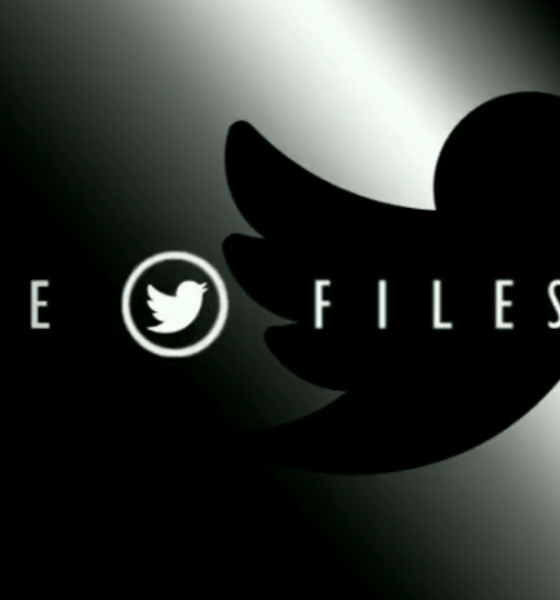
News
Elon Musk’s Twitter Files reveals former executives’ abuse of power, trust & safety
Elon Musk’s Twitter Files revealed quite a bit of detail about the former executives’ abuse of power while running the platform. In November, Elon Musk promised to release evidence of Twitter’s suppression of free speech and, on Friday, announced that he would unveil Twitter’s role in suppressing the Hunter Biden laptop news.
Elon Musk announced earlier on Friday that there would be a live Q&A, and we’ll update here when it goes live.
Here we go!! 🍿🍿 https://t.co/eILK9f3bAm
— Elon Musk (@elonmusk) December 2, 2022
In his thread, Taibbi said that the Twitter Files “tell an incredible story from inside one of the world’s largest and most influential social media platforms.” He began by highlighting Twitter’s early days as a potential tool for enabling mass communication, “making a true real-time global conversation possible for the first time.”
He then shared that some of Twitter’s first tools for controlling speech were designed to combat spammers and financial fraudsters, but slowly over time, Twitter’s staff and executives began to find more users for the tools. “Outsiders began petitioning the company to manipulate speech as well,” Taibbi tweeted, adding that it was just a little at first, then more often, and then constantly.
9. Celebrities and unknowns alike could be removed or reviewed at the behest of a political party: pic.twitter.com/4uzkHnQ65E
— Matt Taibbi (@mtaibbi) December 2, 2022
In the tweets above, Taibbi shared screenshots documenting that requests from “connected actors to delete tweets were routine.” Executives would write one another statements such as “Move to review from the Biden team.” and another one would reply, “handled.”
In addition to that, both celebrities and “unknowns” could be removed or reviewed “at the behest of a political party.”
Taibbi noted that both parties, such as the Trump White House and the Biden campaign, had requests received and honored, but the system wasn’t balanced. Instead, he said, it was based on contacts.
“Because Twitter was and is overwhelmingly staffed by people of one political orientation, there were more channels, more ways to complain, open to the left (well, Democrats) than the right.”
Taibbi shared a link with that statement from Open Secrets, which showed Twitter’s contributions to politicians. Following that, Taibbi shared more documents noting that the slant in content moderation decisions is visible and is the assessment of multiple current and high-level executives.
The Twitter Files, Part One: How and Why Twitter Blocked the Hunter Biden Laptop Story
In Part Of the Twitter Files, Taibbi started with the October 14, 2020, New York Post article titled BIDEN SECRET E-MAILS. “Twitter took extraordinary steps to suppress the story, removing links and posting warnings that it may be ‘unsafe.’ They even blocked its transmission via direct message, a tool hitherto reserved for extreme cases, e.g. child pornography,” Taibbi wrote.
Taibbi shared that Twitter locked White House spokeswoman Kaleigh McEnany out of her account for tweeting about the story, which prompted a letter from the Trump campaign staffer, Mike Hahn, who said, “At least pretend to care for the next 20 days.”
In response to that, Caroline Strom, Twitter’s public policy executive, sent out a “polite WTF query.” Taibbi noted that several employees picked up on the tension between the comms and policy teams and the safety and trust teams. The former had either little or less control over moderation.
“Strom’s note returned the answer that the laptop story had been removed for violation of the company’s “hacked materials” policy,” Taibbi wrote, sharing a screenshot of an email from Elaine Ong Sotto, Ops Analyst, Global Escalations Team. He also shared an archived webpage of Twitter’s Distribution of Hacked Material policy.
Continuing his thread, Taibbi pointed out that several sources heard about a general warning from federal law enforcement that summer about possible foreign hacks. He added that he hasn’t seen any evidence of any government involved in the laptop story. “In fact, that might have been the problem…”
He added that the decision was made at the highest levels of Twitter without the knowledge of Jack Dorsey, the platform’s then-CEO. Vijaya Gadde, Twitter’s former head of legal policy and trust, played a key role, Taibbi wrote.
24. “They just freelanced it,” is how one former employee characterized the decision. “Hacking was the excuse, but within a few hours, pretty much everyone realized that wasn’t going to hold. But no one had the guts to reverse it.”
— Matt Taibbi (@mtaibbi) December 3, 2022
In the next tweet, Taibbi shared an exchange between Gadde and Yoel Roth, Twitter’s former trust and safety head. Trenton Kennedy, the comms official, wrote, “I’m struggling to understand the policy basis for marking this as unsafe.”
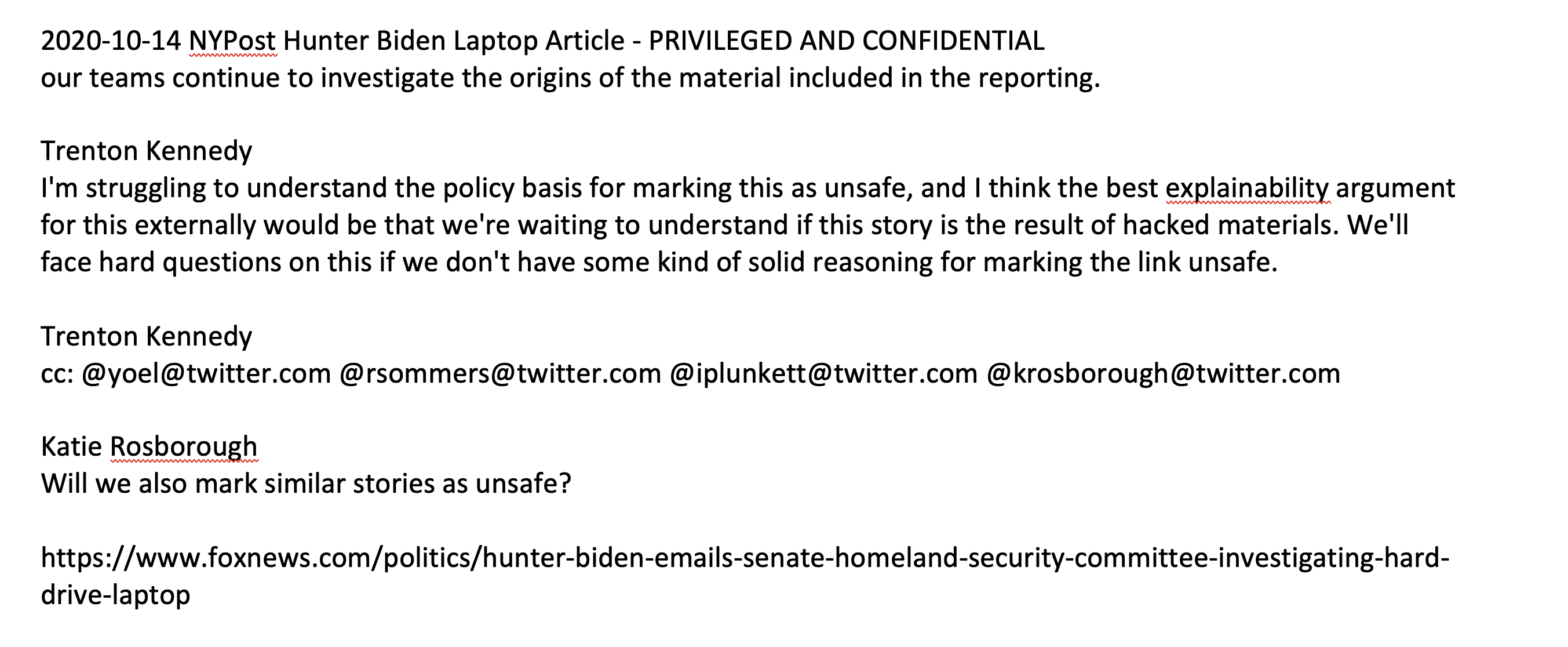
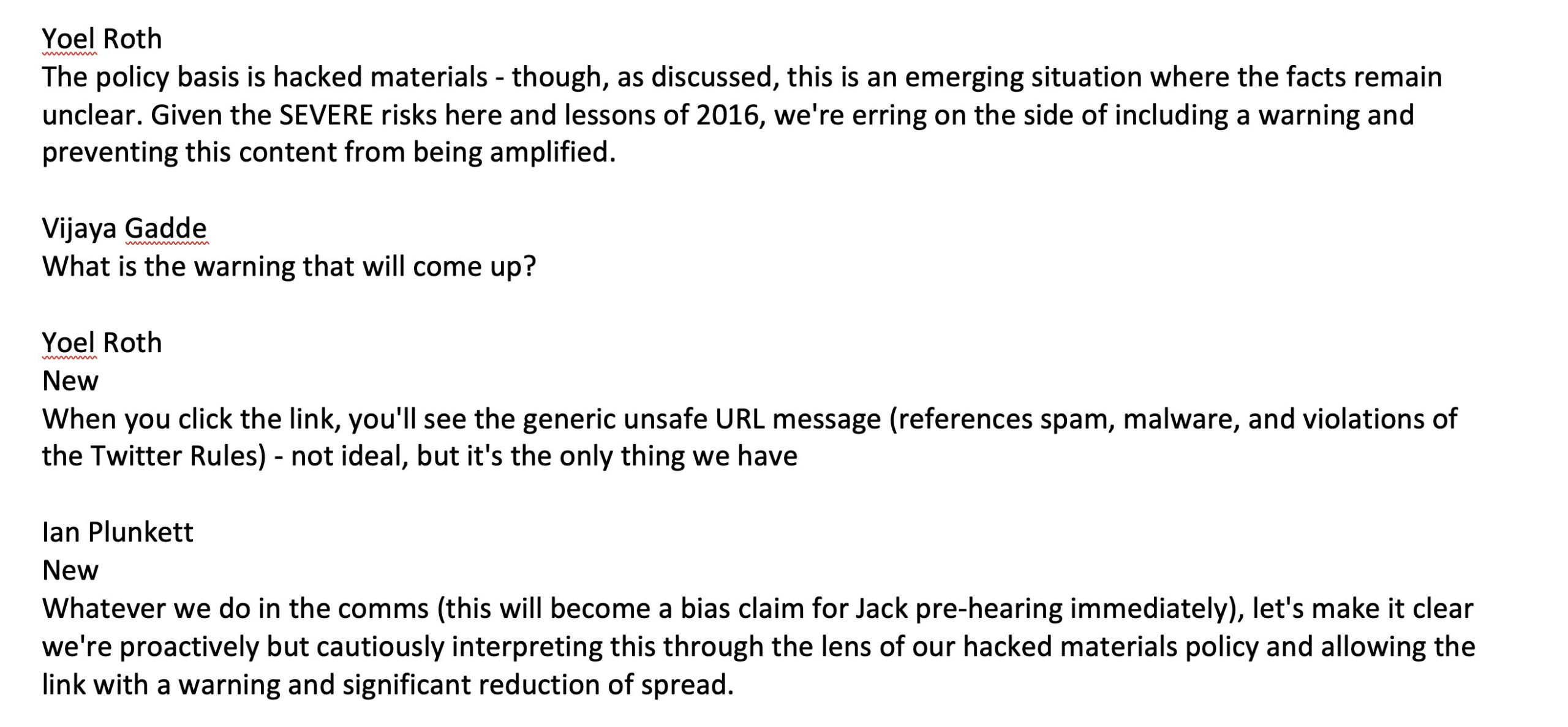
Continuing on, Taibbi noted that Twitter’s former VP of Global Comms, Brandon Borrman asked if the team could truthfully claim that this was a part of Twitter’s policy. In response, the platform’s former Deputy General Counsel, Jim Baker, “seems to advise staying the non-course because ‘caution is warranted.’

Taibbi noted that a fundamental problem with tech companies and content moderation is that there are many people in charge of speech, yet they know or care little about it. He then shared an exchange between Democratic congressman Ro Khanna and Gadde.

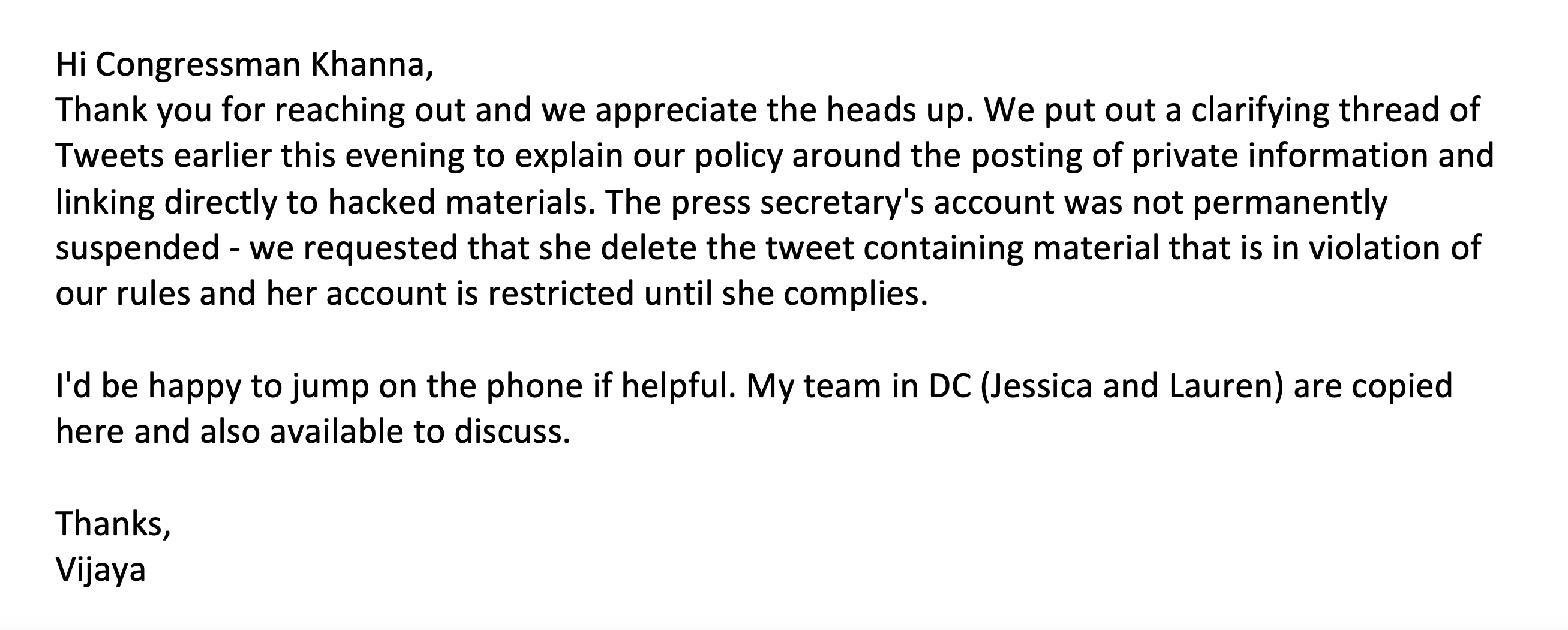
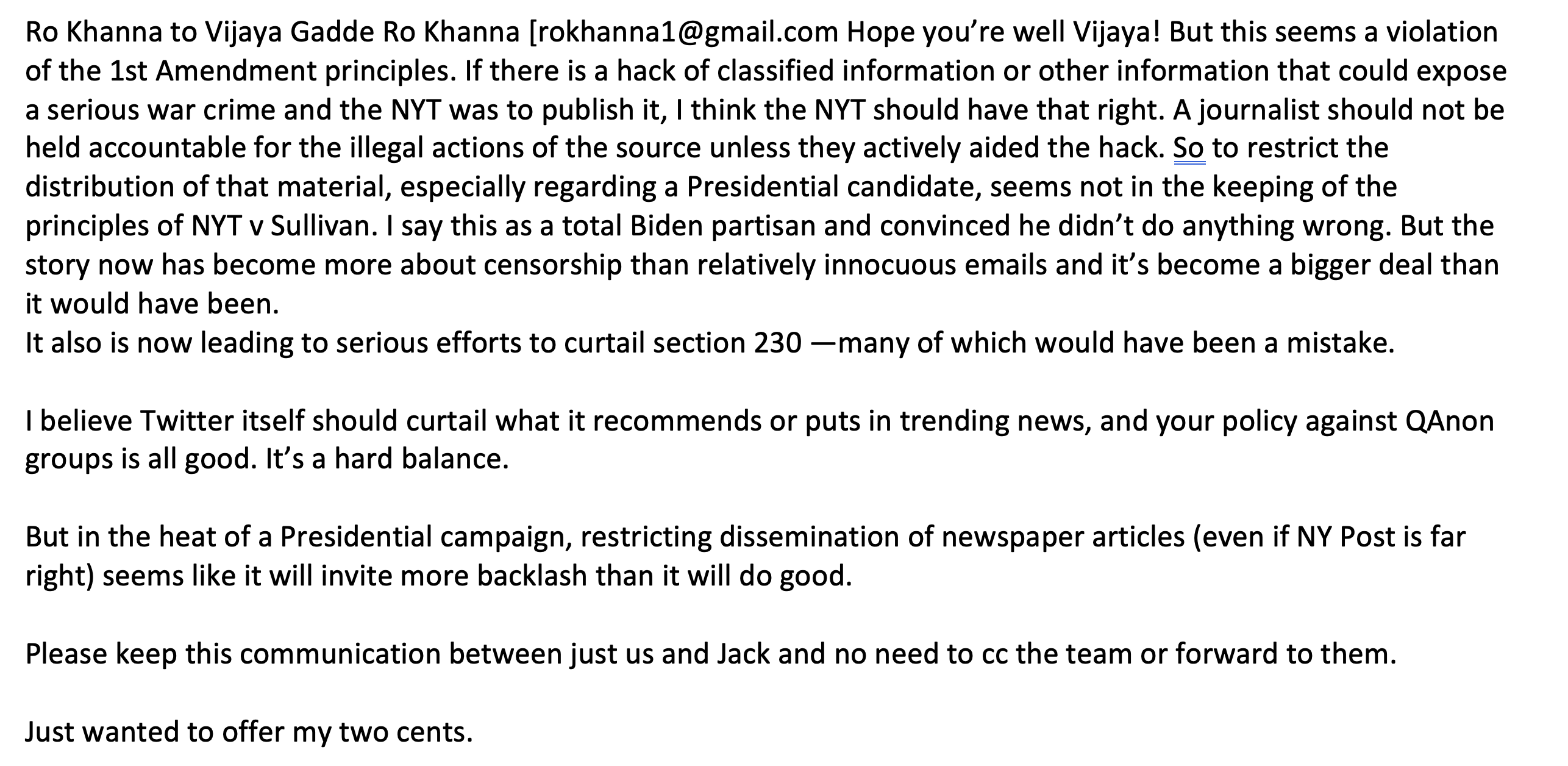
Following the above communications, Taibbi noted that the head of public policy, Lauren Culbertson received a “ghastly letter/report from Carl Szabo of the research firm, NetChoice.” The firm polled twelve members of congress:9 Republicans and 3 Democrats from “the House Judiciary Committee to Rep. Judy Chu’s office.”
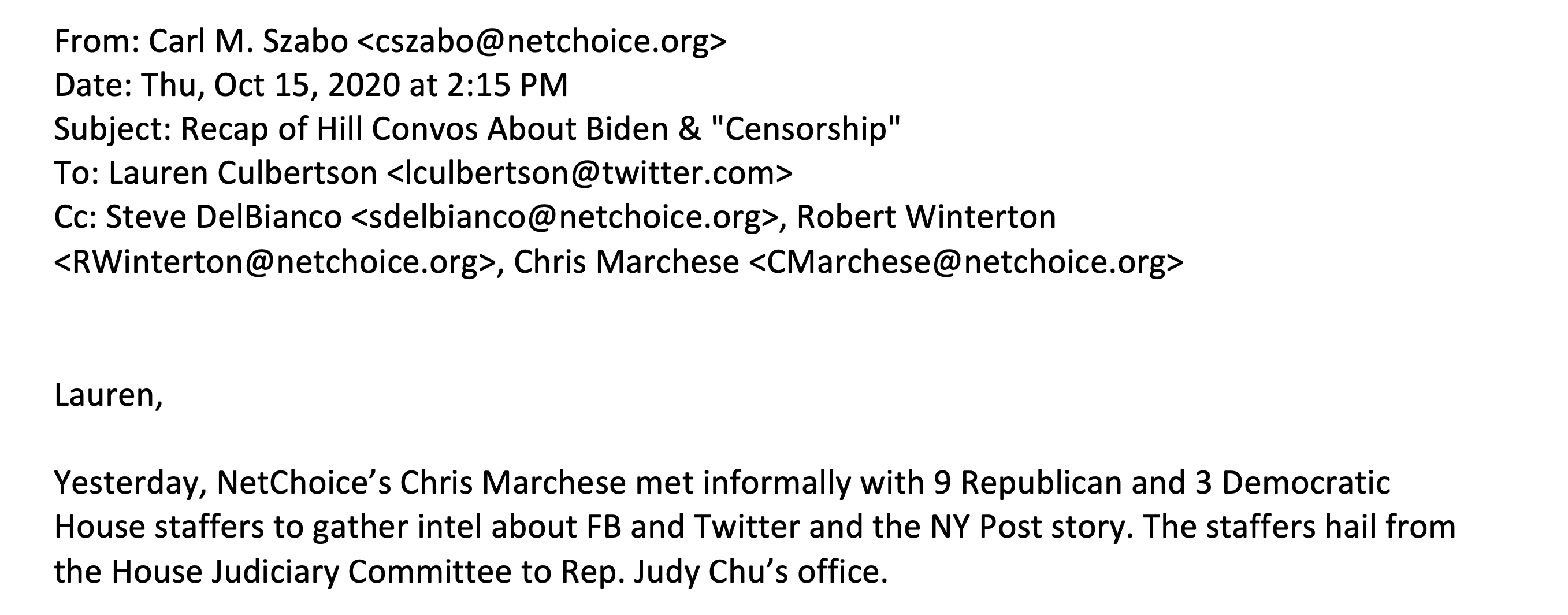
Continuing his thread, Taibbi pointed out that NetChoice informed Twitter that a “blood bath” awaited in upcoming Hill hearings. The screenshot he shared read: “High level take away–Every Republican said ‘this is a tipping point. It’s just too much.’ And both Democrats and Republicans were angry.”
The next screenshot Szabo that Taibbi shared read: “When asked just how bad this situation is, one staffer said: ‘it’s tech’s Access Hollywood moment and it has no Hillary to hide behind.’ Others were more blunt: ‘tech is screwed and rightfully so.’”
In the following screenshot, Taibbi described Szabo’s letter as containing “chilling passages relaying Democratic lawmakers’ attitudes. They want ‘more’ moderation, and as for the Bill of Rights, it’s ‘not absolute.’”
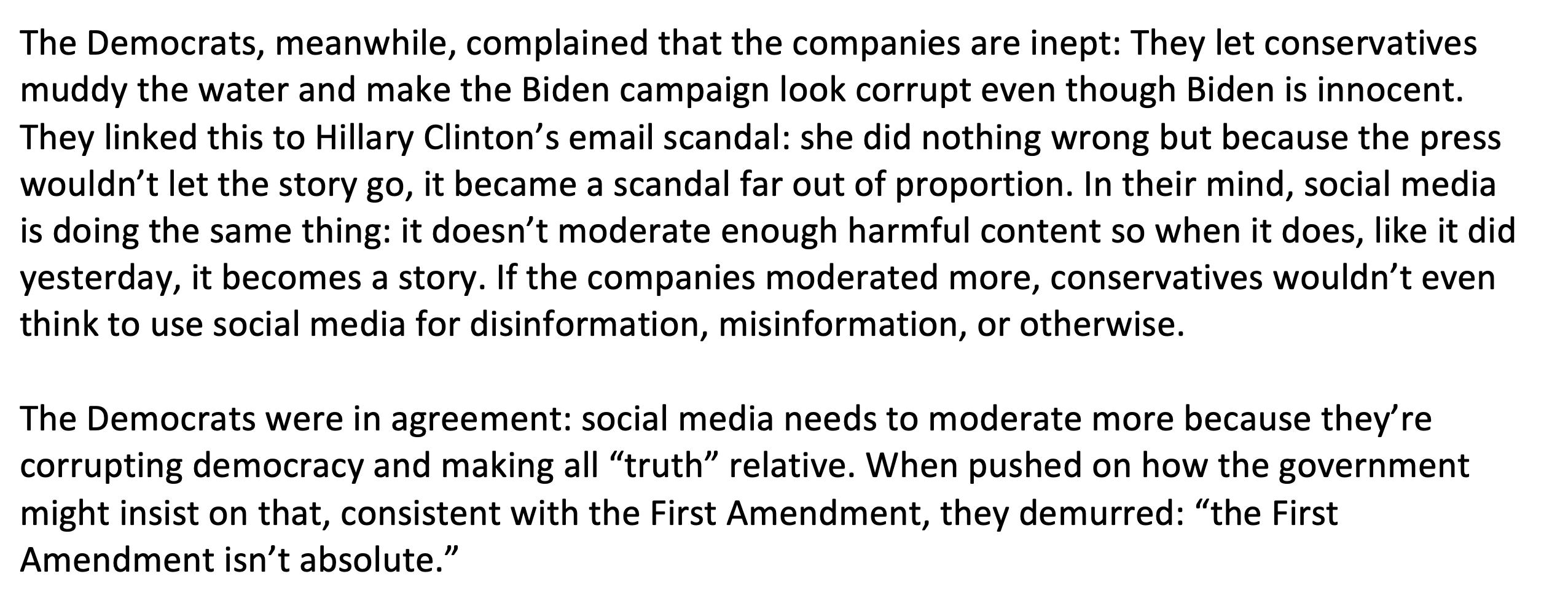
Taibbi commented that an amazing subplot of the Twitter/Hunter Biden laptop affair “was how much was done without the knowledge of CEO Jack Dorsey, and how long it took for the situation to get ‘unfucked’ (as one ex-employee put it) even after Dorsey jumped in.”
As he looked through Gadde’s emails, Taibbi noted a familiar name–his own. Jack Dorsey emailed her a copy of his Substack article blasting the incident, he noted. He added that there were multiple instances in the files where Dorsey intervened to question suspensions and other moderation actions for accounts across the political spectrum.
Your feedback is welcome. If you have any comments or concerns or see a typo, you can email me at johnna@teslarati.com. You can also reach me on Twitter at @JohnnaCrider1.
Teslarati is now on TikTok. Follow us for interactive news & more. Teslarati is now on TikTok. Follow us for interactive news & more. You can also follow Teslarati on LinkedIn, Twitter, Instagram, and Facebook.

Elon Musk
Starlink passes 9 million active customers just weeks after hitting 8 million
The milestone highlights the accelerating growth of Starlink, which has now been adding over 20,000 new users per day.

SpaceX’s Starlink satellite internet service has continued its rapid global expansion, surpassing 9 million active customers just weeks after crossing the 8 million mark.
The milestone highlights the accelerating growth of Starlink, which has now been adding over 20,000 new users per day.
9 million customers
In a post on X, SpaceX stated that Starlink now serves over 9 million active users across 155 countries, territories, and markets. The company reached 8 million customers in early November, meaning it added roughly 1 million subscribers in under seven weeks, or about 21,275 new users on average per day.
“Starlink is connecting more than 9M active customers with high-speed internet across 155 countries, territories, and many other markets,” Starlink wrote in a post on its official X account. SpaceX President Gwynne Shotwell also celebrated the milestone on X. “A huge thank you to all of our customers and congrats to the Starlink team for such an incredible product,” she wrote.
That growth rate reflects both rising demand for broadband in underserved regions and Starlink’s expanding satellite constellation, which now includes more than 9,000 low-Earth-orbit satellites designed to deliver high-speed, low-latency internet worldwide.
Starlink’s momentum
Starlink’s momentum has been building up. SpaceX reported 4.6 million Starlink customers in December 2024, followed by 7 million by August 2025, and 8 million customers in November. Independent data also suggests Starlink usage is rising sharply, with Cloudflare reporting that global web traffic from Starlink users more than doubled in 2025, as noted in an Insider report.
Starlink’s momentum is increasingly tied to SpaceX’s broader financial outlook. Elon Musk has said the satellite network is “by far” the company’s largest revenue driver, and reports suggest SpaceX may be positioning itself for an initial public offering as soon as next year, with valuations estimated as high as $1.5 trillion. Musk has also suggested in the past that Starlink could have its own IPO in the future.
News
NVIDIA Director of Robotics: Tesla FSD v14 is the first AI to pass the “Physical Turing Test”
After testing FSD v14, Fan stated that his experience with FSD felt magical at first, but it soon started to feel like a routine.

NVIDIA Director of Robotics Jim Fan has praised Tesla’s Full Self-Driving (Supervised) v14 as the first AI to pass what he described as a “Physical Turing Test.”
After testing FSD v14, Fan stated that his experience with FSD felt magical at first, but it soon started to feel like a routine. And just like smartphones today, removing it now would “actively hurt.”
Jim Fan’s hands-on FSD v14 impressions
Fan, a leading researcher in embodied AI who is currently solving Physical AI at NVIDIA and spearheading the company’s Project GR00T initiative, noted that he actually was late to the Tesla game. He was, however, one of the first to try out FSD v14.
“I was very late to own a Tesla but among the earliest to try out FSD v14. It’s perhaps the first time I experience an AI that passes the Physical Turing Test: after a long day at work, you press a button, lay back, and couldn’t tell if a neural net or a human drove you home,” Fan wrote in a post on X.
Fan added: “Despite knowing exactly how robot learning works, I still find it magical watching the steering wheel turn by itself. First it feels surreal, next it becomes routine. Then, like the smartphone, taking it away actively hurts. This is how humanity gets rewired and glued to god-like technologies.”
The Physical Turing Test
The original Turing Test was conceived by Alan Turing in 1950, and it was aimed at determining if a machine could exhibit behavior that is equivalent to or indistinguishable from a human. By focusing on text-based conversations, the original Turing Test set a high bar for natural language processing and machine learning.
This test has been passed by today’s large language models. However, the capability to converse in a humanlike manner is a completely different challenge from performing real-world problem-solving or physical interactions. Thus, Fan introduced the Physical Turing Test, which challenges AI systems to demonstrate intelligence through physical actions.
Based on Fan’s comments, Tesla has demonstrated these intelligent physical actions with FSD v14. Elon Musk agreed with the NVIDIA executive, stating in a post on X that with FSD v14, “you can sense the sentience maturing.” Musk also praised Tesla AI, calling it the best “real-world AI” today.
News
Tesla AI team burns the Christmas midnight oil by releasing FSD v14.2.2.1
The update was released just a day after FSD v14.2.2 started rolling out to customers.

Tesla is burning the midnight oil this Christmas, with the Tesla AI team quietly rolling out Full Self-Driving (Supervised) v14.2.2.1 just a day after FSD v14.2.2 started rolling out to customers.
Tesla owner shares insights on FSD v14.2.2.1
Longtime Tesla owner and FSD tester @BLKMDL3 shared some insights following several drives with FSD v14.2.2.1 in rainy Los Angeles conditions with standing water and faded lane lines. He reported zero steering hesitation or stutter, confident lane changes, and maneuvers executed with precision that evoked the performance of Tesla’s driverless Robotaxis in Austin.
Parking performance impressed, with most spots nailed perfectly, including tight, sharp turns, in single attempts without shaky steering. One minor offset happened only due to another vehicle that was parked over the line, which FSD accommodated by a few extra inches. In rain that typically erases road markings, FSD visualized lanes and turn lines better than humans, positioning itself flawlessly when entering new streets as well.
“Took it up a dark, wet, and twisty canyon road up and down the hill tonight and it went very well as to be expected. Stayed centered in the lane, kept speed well and gives a confidence inspiring steering feel where it handles these curvy roads better than the majority of human drivers,” the Tesla owner wrote in a post on X.
Tesla’s FSD v14.2.2 update
Just a day before FSD v14.2.2.1’s release, Tesla rolled out FSD v14.2.2, which was focused on smoother real-world performance, better obstacle awareness, and precise end-of-trip routing. According to the update’s release notes, FSD v14.2.2 upgrades the vision encoder neural network with higher resolution features, enhancing detection of emergency vehicles, road obstacles, and human gestures.
New Arrival Options also allowed users to select preferred drop-off styles, such as Parking Lot, Street, Driveway, Parking Garage, or Curbside, with the navigation pin automatically adjusting to the ideal spot. Other refinements include pulling over for emergency vehicles, real-time vision-based detours for blocked roads, improved gate and debris handling, and Speed Profiles for customized driving styles.








